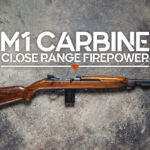
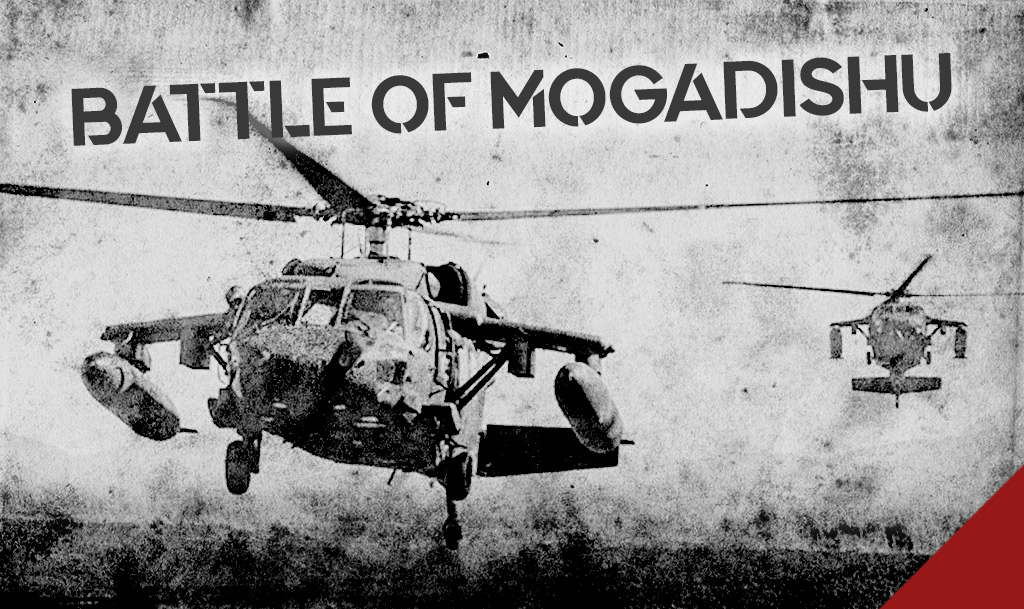
By Guy J. Sagi
The bloodiest single firefight involving U.S. troops since the Vietnam War is the Battle of Mogadishu. It began on October 3, 1993, and raged into the next day. Outnumbered, outgunned, and with reinforcing troops unable to reach them, 18 Armed Forces members died in this chaotic urban combat. The casualties also included another 73 wounded.
Two Black Hawks went down in hostile territory. Delta Team members Master Sgt. Gary Gordon and Sgt. First Class Randy Shughart died after running out of ammunition. The enemy then captured the lone surviving pilot of the crash – Chief Warrant Officer 4 Michael Durant.
Durant, immobilized by the injuries he suffered when the chopper crashed, remained a hostage for 11 days. He spent much of that time in front of a camera, an unwilling public relations token. Meanwhile, other terrorists dragged, displayed, and desecrated the remains of the U.S. military members who were left behind. Videos of the travesty dominated network news for weeks, created public outrage, and ultimately resulted in withdrawal from Somalia in 1995.
The initial United States mission began several years before, in concert with the United Nations. It originally had nothing to do with combat. A short look at Somalia’s instability provides a better understanding of the engagement and why otherwise peaceful civilians eagerly helped make it a deadly one.
Background: The Battle of Mogadishu
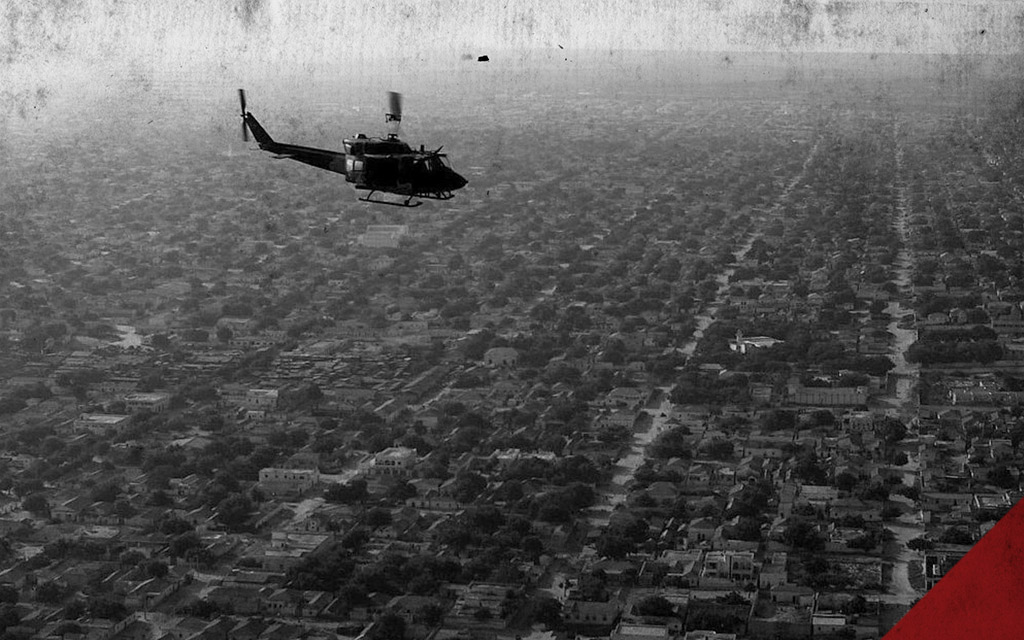
A US Marine Corps helicopter hovering over Mogadishu, Operation Hope, 1992. (Getty Images)
In 1991, armed rebels toppled the Somali government. However, the successful revolt wasn’t the product of a single, unified force. It was the cumulative effort of warring clans – each working separately to claim reign over different sections of real estate.
Still, toppling the regime didn’t bring peace. Fighting continued to rage between several factions that wanted a piece of Somalia’s crown jewel – Mogadishu, the country’s capital. Civilian casualties mounted, food became scarce in the disorder, and starvation followed. The United Nations launched Operation Unified Task Force to prevent a humanitarian crisis. Its food-delivering flights began arriving in 1992.
Doomed To Fail
Unfortunately, bringing supplies to those who needed them required moving much of them through areas occupied by different clans. Confiscation, “taxing,” or destruction of the shipments became commonplace. Officials estimate that up to 80 percent of the relief effort never reached its destination. The rebels got fat off the generosity of others.
The crisis worsened, and Somali starvation estimates came in at roughly 300,000 from 1991 to 1992. With U.N. blessings, the United States launched Operation United Task Force. The first of our 25,000 troops began to arrive in December 1992. An increase in flight volume followed, along with enhanced shipment security.
Tensions Escalate
A large contingent of the U.S. military did little to defuse tensions. Confrontations continued, although most didn’t end in gunfire. The ambush of a United Nations team on June 5, 1993, five months before the Battle of Mogadishu, signaled a deadly change in course. Twenty-four Pakistani peacekeepers died that day — another 57 wounded — as they inspected an arms cache housed at Radio Mogadishu. Among the injured were three American servicemen and one Italian.
The United Nations quickly passed a resolution calling for the arrest of the attackers, noting all were members of the Somali National Alliance (S.N.A.) — the most powerful clan in the war-torn country. A U.S. Navy Admiral followed with a $25,000 reward for information leading to the capture of the group’s commander, thought to be the rebel mastermind.
The Attack: Battle Of Mogadishu
The following month, intelligence sources indicated that a scheduled S.N.A. meeting would have its top commanders and leader in attendance. U.S. forces leveled the site from the air when the affair began, taking out much of the clan’s command structure. Unfortunately, the assault also claimed the lives of a few Somalis, who many of their countrymen theorized had little to do with the ongoing fighting. Anger against the United States grew in the region.
The S.N.A’s leader was not in attendance the day the bombs fell. In August 1993, he responded with a public call for attacks on American troops. The bloodshed began almost immediately with IEDs, remotely detonated mines, mortar barrages, and more.
For those with boots on the ground, the threat escalated into a daily occurrence. Yet from a Washington, D.C., perspective, the risk didn’t outweigh the benefits of providing food for starving Somalis. President Bill Clinton dispatched Task Force Ranger to capture the group’s leader, hoping his removal would clear the supply routes, avert the looming humanitarian disaster, and help establish a stable government.
The S.N.A. Strategy
Prior to the Battle of Mogadishu, Task Force Ranger had conducted six raids. S.N.A. leaders studied the tactics in each and noted the U.S. doctrine of speed and surprise. They, in turn, cleverly devised their own quick-response systems to slow the attack and hamper attempts at surgical extraction. The strategy would buy time for its forces to amass, organize, and engage.
The rebels also noted a reliance on air support, particularly helicopters. They shot down a Black Hawk helicopter in late September 1993 with a Rocket-Propelled Grenade (RPG). With that renewed confidence, they made the distribution of those shoulder-fired, man-portable systems widespread in Mogadishu.
The U.S. Plan
U.S. Intelligence sources indicated that two of the S.N.A.’s top lieutenants would be in a meeting in a building near Mogadishu’s Olympic Hotel. The plan was to snatch the duo in an operation that would last only an hour — less, if luck held.
Yet the op location was close to the Bakara Market, a heavily armed section of the city. Only a week before, the Task Force Ranger garrison commander warned that if U.S. troops entered that area, “…there’s no question we’ll win the gunfight. But we might lose the war.”
The Battle Of Mogadishu
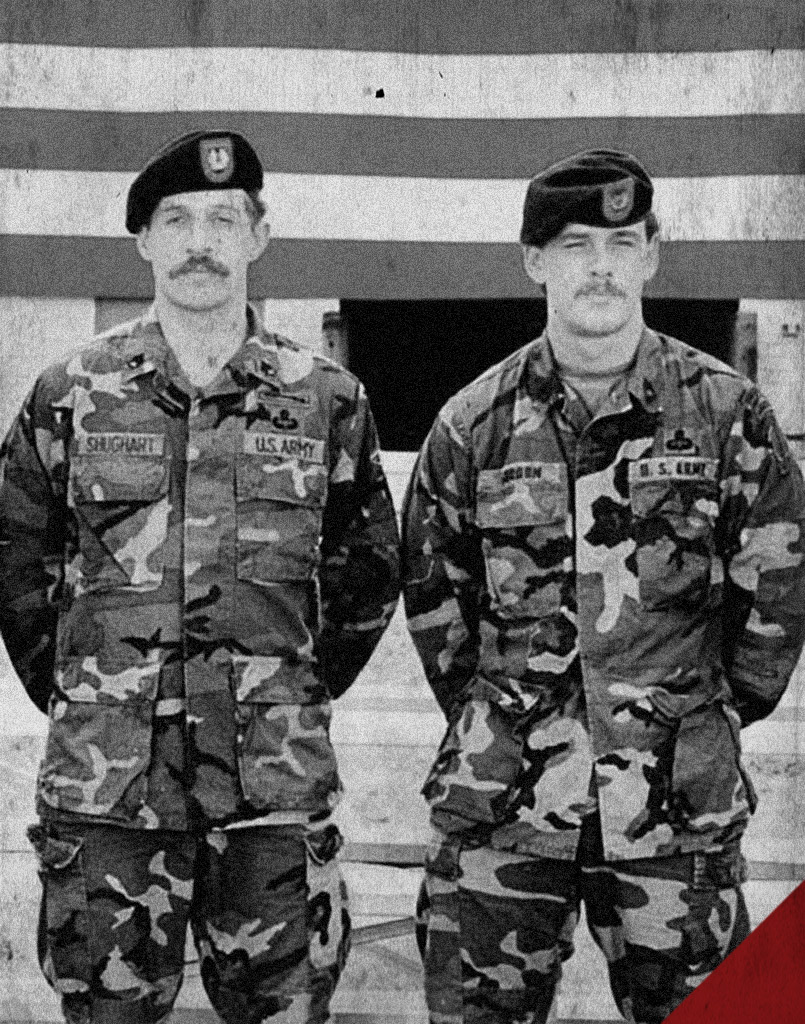
Medal of Honor recipients: (Left) Sgt. First Class Randy Shughart, (Right) Master Sgt. Gary Gordon.
Despite that ominous warning, the operation began on the afternoon of Oct. 3. Confirmation had arrived that the targets were in the building. It started at 3:40 p.m. with a pair of gunships surveying the area. Four helicopters touched ground seconds later, discharging 16 Delta Team members. Thirty more Special Forces members followed.
Five minutes later, four more helicopters arrived, each carrying four Rangers whose mission was to fast-rope in and establish separate sections of the outer security perimeter. One of them, Chalk Four, took incoming fire during the insertion.
After an RPG exploded dangerously close to the bird, the chopper put its Soldiers down a block away from their designated drop zone. Worse yet, one member of that team fell from the rope and needed immediate medical attention. The incoming fire arrived almost immediately, much sooner than during any previous operation.
One-Way Ticket To Chaos
Meanwhile, the first convoy of Humvees left the garrison. Observers noted tires burning shortly after their departure, a signal that American troops were approaching. Hastily-built barricades blocked many of the city’s streets by the time U.S Forces arrived on clan-controlled soil. Incoming fire was fierce, slowing their progress further. When they reached the hotel, Delta had 24 prisoners in tow and ready to load.
The troops immediately loaded the fallen Ranger – whose condition was now critical – into one of the Humvees. The vehicle made it to the garrison and the advanced medical care there, but not before one of its soldiers fell victim to the heavy incoming fire.
Things Go South
A rocket-propelled grenade (RPG) hit the first Black Hawk (Super 61) and it went down at 4:20 p.m., roughly 300 yards from the hotel as prisoner loading commences. Within minutes, U.S. ground teams fought their way to the crash, hoping to recover survivors and provide evacuation security.
It took only 8 minutes for a Black Hawk with a search and rescue team to arrive overhead. That team recovered one of the pilot’s bodies and was still struggling to free the other dead aviator. The chopper then took damage from an RPG, forcing it back to base.
The 90 Soldiers at the site remained, tending the two wounded crew members, one of whom died later. Rather than allow the outnumbered force to remain divided, those troops with the prisoners began driving toward the crash.
Air Support Fails
Then a second Black Hawk (Super 64) went down a half mile away, again the victim of an RPG. Orders followed for ground troops to secure that site as well, so the convoy changed course. With all the roadblocks, it was a meandering affair. An Orion P-3 fixed-wing aircraft high above provided directions. These communications were slow to arrive and confusing. In the intense small-arms fire, they bordered on unintelligible.
For 45 minutes, the ground troops drove through a Mogadishu gauntlet, only to find themselves back at the hotel. The Humvees were severely damaged by that time, and casualties were growing. What remained of the convoy received the order to leave the city at 5:15 p.m.
The Reinforcements Arrive
Meanwhile, an ad-hoc force of 27 Rangers left the garrison in five Humvees and two five-ton trucks at 5:03 p.m. The much-needed relief fell under ambush immediately and ran into roadblocks as they probed alternate routes. When it was apparent it could not reach the objective, the command issued orders for its return to base.
The 10th Mountain Quick Reaction Force first mustered at 4:29 p.m. This force found itself delayed when directed to take a longer, safer route. It finally linked up with additional forces and attempted to enter the city at 5:35 p.m. but quickly encountered stiff resistance. By 6:10 p.m., elements of the group were pinned down. It withdrew from the battle at 6:30.
The only team to successfully reach the second Black Hawk (Super 64) to go down was Master Sgt. Gary Gordon and Sgt. First Class Randy Shughart. Those soldiers, armed with only personal weapons guarded the first crash site and fought through the night. Master Sgt. Gordon carried a CAR-15 rifle (chambered in 5.56) and pistol, while Sgt. First Class Randy Shughart carried an M14 rifle (chambered in 7.62×51) and sidearm.
Rescue by Pakistani and Malaysian armored vehicles – along with U.S. trucks and Humvees – arrived the next day. However, their efforts were too late. Master Sgt. Gary Gordon and Sgt. First Class Randy Shughart made the ultimate sacrifice, laying down their lives, to protect their fellow soldiers. They were both posthumously awarded the Medal of Honor on May 23, 1994.
Rescue operations took as many troops out as they could carry. However, there wasn’t enough room to carry every soldier. Many ran alongside the column, joined by stragglers who’d somehow survived the night. That “Mogadishu Mile” is honored annually in runs across the United States.
Aftermath: Battle Of Mogadishu
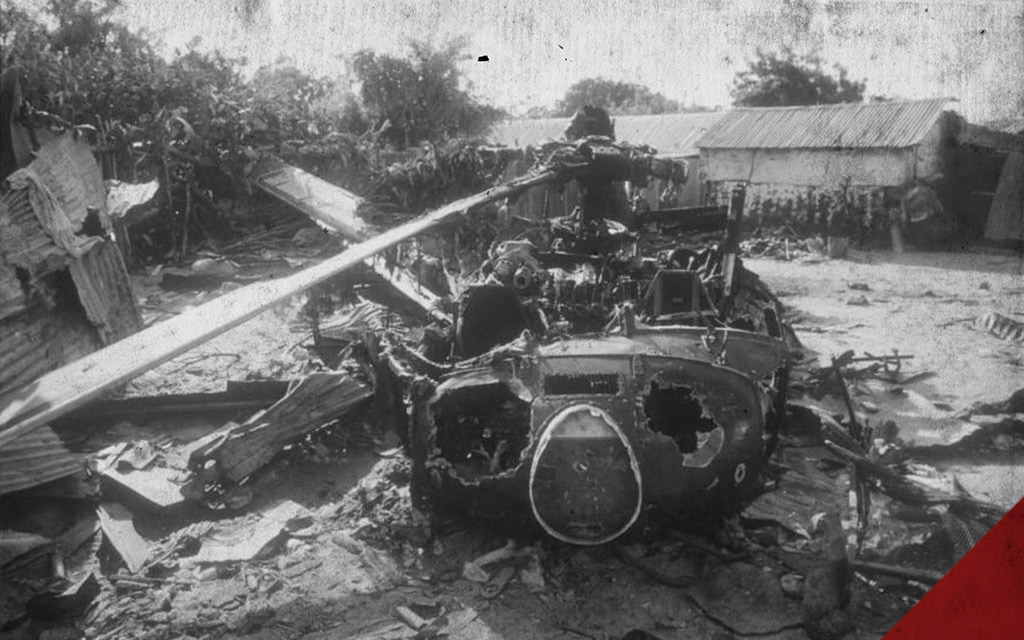
Wreckage of a black hawk helicopter identified as Super 64, October 14, 1993, in Mogadishu, Somalia. (Getty Images)
Arguably, U.S. intelligence may bear the brunt of the blame for what happened to our troops during the Battle of Mogadishu. They knew the city held 2.5 million angry-at-America Somalis eager to shoot anyone in a U.S. uniform. That’s why they stressed the need for one-hour speed.
However, no one seemed to know that S.N.A. troop strength was anywhere from 1,400 and 4,000. The S.N.A. was also far from a disorganized rebel rabble. Their city defense consisted of 18 distinct sectors, each with a commander awake and on duty every hour of the day. Two-way radios linked their posts, and each district had a hasty team at its disposal capable of responding within 30 minutes.
To make matters worse, U.S. contingency plans were non-existent. There was no prior notification of military leaders from the other United Nations forces close enough to render aid such as Pakistan and Malaysia. That silence was ostensibly to maintain the security of the operation.
Perhaps more disturbing is the fact that U.S. commanders recognized the growing risk to U.S. troops. Long before Oct. 3, Task Force Ranger command asked for tanks so they’d have vehicles armored better than the Humvees. They also asked for AC-130 gunships, but the Pentagon denied their requests.
The movie “Black Hawk Down” does an admirable job of portraying the grit, determination, and self-sacrifice of our troops during the engagement. It was only their skill and dedication during those fateful days that rose above the S.N.A’s home-field advantage and prevented the deadly Battle of Mogadishu from becoming even deadlier.


